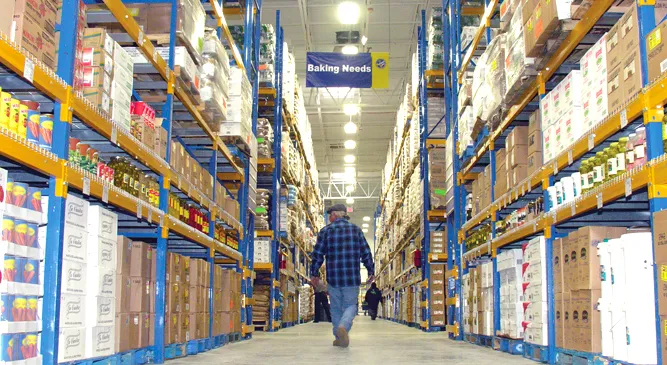Bulk Buying vs. Dropshipping: Which Wholesale Grocery Model is Right for You?
Posted at: 07-Feb-2025
Summary
Choosing between bulk buying and
dropshipping when working with wholesale grocery suppliers can impact your business success. This guide explores
the pros and cons of each model, helping you decide which is best for your
grocery store, eCommerce business, or retail shop. Learn how to maximize
profits while minimizing risks.
Understanding
Wholesale Grocery Suppliers
Wholesale grocery suppliers provide
bulk food products, beverages, and household essentials to businesses at
discounted rates. They serve retailers, eCommerce businesses, and restaurants,
ensuring a steady supply of goods at competitive prices.
When sourcing groceries from wholesale grocery suppliers,
businesses typically choose between bulk buying and dropshipping.
Let’s break down each model to help you determine which is the right fit for
your business.
What is Bulk Buying
from Wholesale Grocery Suppliers?
Bulk buying involves purchasing
large quantities of groceries from wholesale grocery suppliers at a discounted price and storing them for resale.
This model is common among grocery stores, supermarkets, and large-scale
retailers.
Pros of Bulk Buying
- Lower Cost Per Unit
– Buying in bulk often leads to lower prices and higher profit margins.
- Better Inventory Control – You have full control over your stock, ensuring
availability for customers.
- Faster Order Fulfillment – Since you store products in-house, you can quickly
fulfill customer orders.
- Stronger Supplier Relationships – Wholesalers offer better deals to consistent bulk
buyers.
- Brand Control
– You can customize packaging and marketing strategies for the products.
Cons of Bulk Buying
- High Upfront Costs
– Purchasing in bulk requires significant initial investment.
- Storage and Warehousing – You need adequate storage space and inventory
management systems.
- Risk of Spoilage
– Perishable grocery items have limited shelf life, increasing the risk of
waste.
- Market Fluctuations – Prices and demand can change, affecting profitability.
What is
Dropshipping with Wholesale Grocery Suppliers?
Dropshipping allows businesses to
sell groceries online without holding inventory. When a customer places an
order, the supplier ships the product directly to them.
Pros of Dropshipping
- Low Initial Investment – No need to purchase stock upfront, reducing financial
risk.
- No Storage Costs
– The supplier handles warehousing and shipping logistics.
- Wide Product Selection – You can offer a broad range of grocery items without
stocking them.
- Flexible and Scalable
– Dropshipping allows businesses to test products without commitment.
- Reduced Waste
– No risk of product spoilage, as you only order what’s sold.
Cons of Dropshipping
- Lower Profit Margins
– Prices are often higher, leading to smaller profit margins.
- Limited Control Over Inventory – Suppliers may run out of stock or take longer to
ship orders.
- Shipping Delays
– Order fulfillment depends on the supplier’s efficiency.
- Branding Limitations
– Many dropship suppliers do not allow customized packaging.
- Potential Quality Issues – Since you don’t handle the products directly,
quality control can be challenging.
Key Differences
Between Bulk Buying and Dropshipping
|
Feature |
Bulk
Buying |
Dropshipping |
|
Upfront Costs |
High |
Low |
|
Storage Requirement |
Yes |
No |
|
Profit Margins |
Higher |
Lower |
|
Product Control |
High |
Low |
|
Risk of Spoilage |
Yes |
No |
|
Branding Options |
Full |
Limited |
|
Order Fulfillment |
Fast |
Supplier Dependent |
Which Model is Best
for Your Business?
The decision between bulk buying and
dropshipping depends on your business goals, budget, and operational capacity.
Choose Bulk Buying If:
- You have sufficient capital for inventory.
- You own or can rent storage space.
- You want full control over branding and packaging.
- You prefer higher profit margins over time.
- You need to fulfill orders quickly and consistently.
Choose Dropshipping If:
- You’re starting with minimal investment.
- You don’t have storage facilities or want to avoid
inventory management.
- You want to test the grocery market before committing
to bulk orders.
- You prefer flexibility in product selection without
stock limitations.
- You’re focused on an eCommerce or online business
model.
How to Get Started
with Wholesale Grocery Suppliers
For Bulk Buyers:
- Find Reliable Suppliers – Research and partner with reputable wholesale grocery distributors offering competitive pricing.
- Negotiate Pricing
– Bulk discounts and better payment terms can improve profitability.
- Invest in Storage Solutions – Ensure proper warehouse space and inventory
management systems.
- Monitor Demand Trends
– Stock items that have consistent demand to minimize waste.
- Manage Logistics Efficiently – Set up fast shipping methods for customer
satisfaction.
For Dropshippers:
- Select a Niche
– Choose a specific grocery category to target the right audience.
- Partner with Reliable Suppliers – Work with dropshipping-friendly wholesale grocery distributors.
- Optimize Your Online Store – Create an engaging eCommerce website or list on
marketplaces like Amazon, Shopify, or eBay.
- Ensure Transparent Communication – Keep customers informed about shipping times and
product availability.
- Focus on Marketing
– Use SEO, social media, and paid ads to attract buyers.
Final Thoughts
Both bulk buying and dropshipping
offer unique benefits when working with wholesale grocery suppliers. If
you want higher margins and product control, bulk buying is the way to go. If
you prefer a low-risk, flexible business model, dropshipping may be the right
choice.
For high-quality wholesale grocery
products and reliable suppliers, visit Premier ProductsCo. U.S.
